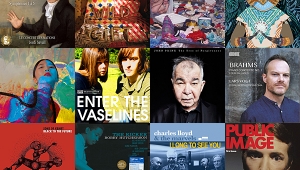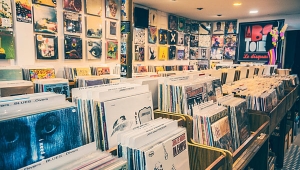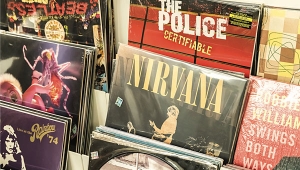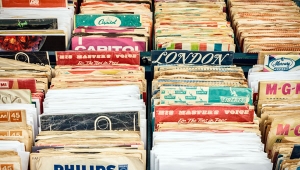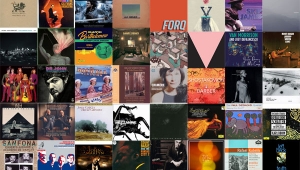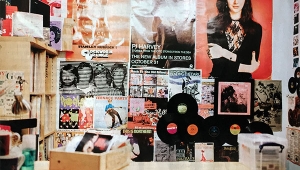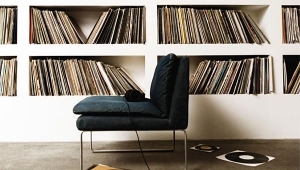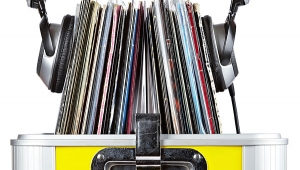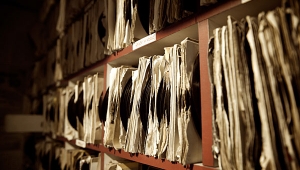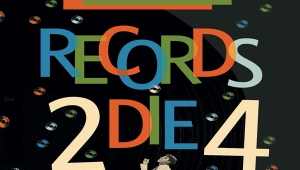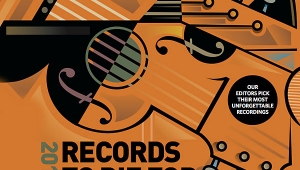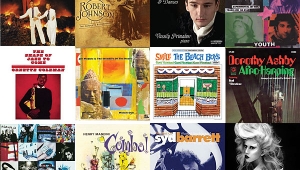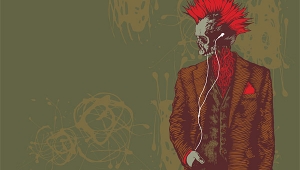| Columns Retired Columns & Blogs |
1992 Records To Die For Page 2
Peter Van Willenswaard
A preliminary remark. Within the realm of this "Recommended Recordings" series I cannot recommend any of the recordings discussed below in the CD format. Although my writings in "Industry Update" quite regularly deal with digital audio, and quite enthusiastically so because of the interesting and often promising developments in that area, no CD that I know of, played through any D/A equipment that I know of, even comes near to what many LPs do to me. I like good CDs, but I love good records. On the occasional evening that I am free of my reviewer's duties and find myself able to switch off that research department in my mind that is always curious why something is as it is or isn't as it should be, and I want to sit back and enjoy music, I play LPs exclusively.
JACQUES BREL: à l'Olympia
François Rauber, Gérard Jouannest, piano; Jean Corti, accordian; orchestra conducted by Daniel Janin
Fontana 858 015 PFY (LP). (Also reprinted as Philips Music for the Millions 6395 216.)
First, a warning. This record usually sounds awful with semiconductor electronics, be they bipolar or MOSFET; I know a few exceptions, but even then, it needs tubes to come alive. Brel (1929-78) was a chansonnier pur sang, in French, but as so many other famous "French" artists he was of Belgian origin and his poetry is unmistakably influenced by his Flemish roots. His live performances were of unequaled power; this one was recorded at the Paris Olympia Theatre in 1962. During live performances Brel tends to forget that he is standing before an audience once the song gets emotional (and a lot of his songs do). He doesn't get introverted or sentimental, but cries his heart out, the words leaving his mouth so fast he nearly stumbles over them. As for the sound, don't think of a pin-point see-through stereo image. But everything is there, alive as if it was yesterday and not 30 years ago.
THE WORLD OF GILBERT & SULLIVAN: Vol.I (excerpts)
D'Oyly Carte Opera Company, New Symphony Orchestra of London; Isidore Godfrey
GILBERT & SULLIVAN: Princess Ida
Sir Malcom Sargent, Royal Philharmonic Orchestra
Decca SPA 28 (2 LPs). (1969 Dutch pressing, carrying a blue label)
The musical style is in between opera and operetta. Now I'm not usually fond of opera, and I hate Austrian operetta, but I love this. The texts are full of humor and quite sharp; this could almost have been written in the late '50s of this century instead of in the Victorian age. Music and text blend together wonderfully. The performance is splendid, everyone really going for it. Sonics are breathtaking and keep improving with each equipment upgrade. There is another Dutch pressing (released in England) with the more traditional Decca blue and red rings around the label which isn't nearly as good. My recently obtained original recordings from 1959 (like SKL 4081&2 for H.M.S. Pinafore) are dynamically better but slightly noisier than my blue-label excerpts album.
STRAVINSKY: Le Sacre du Printemps
Sir Colin Davis, Concertgebouw Orchestra Amsterdam Philips 9500 323 (LP).
This recording was made halfway through the '70s. Philips was pretty good at that time, but this Sacre sticks out. Very silent pressing and excellent dynamics; exactly what this music needs. And of all the interpretations I have heard, this is the most powerful, the most integrated, the most encompassing. Although it isn't mentioned on the cover, it is almost certainly Volker Straus who recorded this. In a recent interview Straus bluntly confessed making an average of 300 cuts, crossfades, or inserts during the mastering of one hour of music (five per minute!). If he did so here, it doesn't show. The sound breathes, the atmosphere of the Concertgebouw is spacious, with very good detail and definition and only very subtle highlighting.
RACHMANINOFF: Piano Concerto 3
Byron Janis, Antal Doráti, London Symphony Orchestra
Mercury SR 90283 (LP). (Dutch pressing by Phonogram; it's a Living Presence, so probably produced/engineered by Cozart and Fine)
Another ca 1960 recording, and like the Brel mentioned above, very difficult to play back properly. It took me years before it became even listenable. And it's not just the turntable that counts, it's the electronics too---everything. But it's splendid, both in interpretation and registration, although the violins have that typical American touch to the sound that is a bit unusual to European ears. Byron's piano is there, in front of the orchestra, in exactly the right perspective and not blown up larger-than-life. Rachmaninoff's Second seems to have been long considered his most famous, but I have always preferred his Third, which I find infinitely more moving.
BILLIE HOLIDAY: Lady in Satin
With Ray Ellis and his orchestra
CBS CS 8084 (LP, early US pressing) CBS S 52540 (LP, later Dutch pressing)
I have hesitated to add this to the list. Not because it might not qualify, but because I fear abuse. There are only very few records that I consider to be for personal use only. This is one of them. So if you respect Billie Holiday and would happen to be at a demo where someone starts to play this to a random audience, please leave the room. If you know the record, you'll know why.
Michael Ullman
CHARLES MINGUS: Blues and Roots
Atlantic SD-1305 (LP). Tom Dowd, eng.; Nesuhi Ertegun, prod. AAA. TT: 60:48
In one crucial way, it's more difficult to judge the sound of a jazz than that of a classical recording. To remind one's ears of the ideal sound of a classical performance, one only has to go to, say, Symphony Hall or Carnegie Hall, and listen to the natural sound of an orchestra or chamber group. Go to a jazz club and you frequently hear a jumble of heavily amplified sounds produced by closely miked instrumentalists. What one almost inevitably finds in a jazz recording is not necessarily the sound of a band playing in a natural space, but a more artificial sound. A jazz recording can nonetheless be satisfying if it carefully separates the strands of the music, if it reproduces accurately the tone of each instrument, and if it is satisfyingly balanced. It might also sound spectacular. I remember playing my new copy of Blues and Roots for roommates and interested listeners in the early '60s. Everyone was thrilled by the stereo separation, by the sound of Mingus's buoyant bass, and by the way the recording made each instrument in these rabble-rousing ensembles sound out. I still find Blues and Roots thrilling, and the sound, tape hiss and all, accurately recreates the ambience of a Mingus performance, if not its every detail.
LEE MORGAN: Tom Cat
Blue Note CDP 7 84446 2 (CD). Rudy Van Gelder, eng.; Michael Cuscuna, prod. AAD. TT: 44:19
I choose this disc, a reissue of a 1964 Lee Morgan session, as an example of the work of one of the best engineers recording jazz in the '60s. I could have chosen other records engineered by Van Gelder---records by Jackie McLean, Freddie Hubbard, or perhaps Eric Dolphy. Van Gelder's famous New Jersey studio was evidently a homey place, where he was able to both relax and bring out the best in a generation of musicians. His recordings were tightly miked, with clear, and perhaps by today's standards extreme, stereo separation. But the instruments he recorded had their natural bite and definition. Tom Cat is a typical mid-'60s Lee Morgan date, made especially satisfying by the playing of altoist Jackie McLean, pianist McCoy Tyner, and the zinging cymbals of drummer Art Blakey.
COUNT BASIE: For the Second Time
Pablo 2310-878 (LP). Ed Green, eng.; Norman Granz, prod. AAA. TT: 37:68
A few weeks before this album came out (in 1975), I had the opportunity to sit within several feet of bassist Ray Brown. I marveled at the breadth and warmth of his tone, and lamented that his sound had rarely been accurately captured on record. Then this marvelous trio disc, featuring Basie, Brown, and drummer Louis Bellson, came out. It seemed miraculous at the time. Basie was one of the great jazz pianists, but many of us thought his best years were behind him. Live, he rarely soloed. Yet this vividly recorded set of music presented Basie as a pianist in a recording notable for its amplitude and warmth. We seem to hear Basie breathe in the spaces he leaves in his renditions of tunes such as "On the Sunny Side of the Street," one of the wittiest performances on record. We can feel him think; he makes it sound so easy.
MEL TORMÉ & BUDDY RICH: Together Again for the First Time
Century CRDD-1100 (LP). Keith Grant, eng.; Norman Schwartz, prod. AAA.
This 1975 direct-to-disc album captures the punch of a Buddy Rich big band better than any other recording I know, and at the same time offers superior singing by Mel Tormé. Tormé sounds close-up; the band, as it should be, is a little distant. The soloists here include guest altoist Phil Woods and pianist Hank Jones, but Tormé and Rich steal the show. Listening to Tormé sing "Here's That Rainy Day" over the comping of the pianist and the obbligato of Phil Woods, I feel that I might be hearing the band in a concert hall, except that then the noise of a live audience would cover up the gradually spreading splash of Rich's cymbal.
HELEN MERRILL/GIL EVANS: Collaboration
Emarcy 834 205-2 (CD only). Tom Lazarus, Rebecca Everett, engs.; Kiyoshi Koyama, Helen Merrill, prods. DDD. TT: 44:49
This disc illustrates the paradox of jazz recording. Helen Merrill has a small, breathy voice. Amplification made her career---and those of most modern singers---possible. Collaboration begins with Merrill singing "Summertime" in a relaxed, out-of-tempo conversation with soprano saxophonist Steve Lacy. There's a feeling of space between and around them, which is suddenly, and impressively, filled by the large Gil Evans orchestra. Evens was a master orchestrator, and his unusual voicings and instrumentation---"Summertime," for instance, features a flute quartet---has never been better recorded. The depth of the sound is impressive---one hears Buster Williams's warm bass, and also on several tracks the clear reedy sound of a bass clarinet. I admire Merrill's intelligent singing---especially in the context of the marvelous Evans arrangements.
Allen St. John
STEELY DAN: Pretzel Logic
MCA MCA-1593 (LP), MCAD-31165 (CD). Roger Nichols, eng.; Gary Katz, prod. AAA/AAD. TT: 33:14
A typically Steely Dan-ish title for Becker and Fagen's most straightforward album. Sure, there's wordplay enough for any frustrated English major and musical references that run the gamut from Horace Silver to Charlie Parker. But there's more. From those wind chimes that remind Rikki about that number to those sleigh bells that toll for Charlie Freak, these are truly tender songs in which irony, for once, takes a back seat to feeling. Sonically, it's not as flashy as Aja, but Roger "The Immortal" Nichols makes ensemble rock a wonderful thing. My LP pressing is horrendously noisy, but surface grundge aside, it's better than the CD reissue. Too bad MFSL never got their hands on this one.
RICHARD & LINDA THOMPSON: Shoot Out the Lights
Hannibal HNBL 1303 (LP), HNCD 1303 (CD*), Bill Gill, eng.; Joe Boyd, prod. AAA/AAD. TTs: 38:22, 40:52*
Have you ever wondered what kind of sound a marriage makes when it falls apart? On their last and best album together, Richard and Linda channel their real-life despair into a majestic song cycle. Comparing the calm beauty of Linda's singing on "Just the Motion" and Richard's anarchic Strat work on the title track will tell you more about the differences between men and women than ten pop psychology books. Due to a nervous tic, many of Linda's vocals had to be patched together, but aside from some extra reverb, there's no evidence of the seams. The CD's a little edgy, but includes "Living in Luxury," a toss-off cut that provides an ironic coda.
KATE & ANNA McGARRIGLE: Kate & Anna McGarrigle
Warner Bros. BS 2862, Carthage CGLP 4401 (LPs only). John Wood, eng.; Joe Boyd, Greg Prestopino, prods. AAA. TT: 34:57
The Warners promo pressing of this record I found a few months ago is, in a word, breathtaking. But it doesn't preclude my last year's recommendation of the still wonderful, and still in print, Carthage reissue.
A preliminary remark. Within the realm of this "Recommended Recordings" series I cannot recommend any of the recordings discussed below in the CD format. Although my writings in "Industry Update" quite regularly deal with digital audio, and quite enthusiastically so because of the interesting and often promising developments in that area, no CD that I know of, played through any D/A equipment that I know of, even comes near to what many LPs do to me. I like good CDs, but I love good records. On the occasional evening that I am free of my reviewer's duties and find myself able to switch off that research department in my mind that is always curious why something is as it is or isn't as it should be, and I want to sit back and enjoy music, I play LPs exclusively.
JACQUES BREL: à l'Olympia
François Rauber, Gérard Jouannest, piano; Jean Corti, accordian; orchestra conducted by Daniel Janin
Fontana 858 015 PFY (LP). (Also reprinted as Philips Music for the Millions 6395 216.)
First, a warning. This record usually sounds awful with semiconductor electronics, be they bipolar or MOSFET; I know a few exceptions, but even then, it needs tubes to come alive. Brel (1929-78) was a chansonnier pur sang, in French, but as so many other famous "French" artists he was of Belgian origin and his poetry is unmistakably influenced by his Flemish roots. His live performances were of unequaled power; this one was recorded at the Paris Olympia Theatre in 1962. During live performances Brel tends to forget that he is standing before an audience once the song gets emotional (and a lot of his songs do). He doesn't get introverted or sentimental, but cries his heart out, the words leaving his mouth so fast he nearly stumbles over them. As for the sound, don't think of a pin-point see-through stereo image. But everything is there, alive as if it was yesterday and not 30 years ago.
THE WORLD OF GILBERT & SULLIVAN: Vol.I (excerpts)
D'Oyly Carte Opera Company, New Symphony Orchestra of London; Isidore Godfrey
GILBERT & SULLIVAN: Princess Ida
Sir Malcom Sargent, Royal Philharmonic Orchestra
Decca SPA 28 (2 LPs). (1969 Dutch pressing, carrying a blue label)
The musical style is in between opera and operetta. Now I'm not usually fond of opera, and I hate Austrian operetta, but I love this. The texts are full of humor and quite sharp; this could almost have been written in the late '50s of this century instead of in the Victorian age. Music and text blend together wonderfully. The performance is splendid, everyone really going for it. Sonics are breathtaking and keep improving with each equipment upgrade. There is another Dutch pressing (released in England) with the more traditional Decca blue and red rings around the label which isn't nearly as good. My recently obtained original recordings from 1959 (like SKL 4081&2 for H.M.S. Pinafore) are dynamically better but slightly noisier than my blue-label excerpts album.
STRAVINSKY: Le Sacre du Printemps
Sir Colin Davis, Concertgebouw Orchestra Amsterdam Philips 9500 323 (LP).
This recording was made halfway through the '70s. Philips was pretty good at that time, but this Sacre sticks out. Very silent pressing and excellent dynamics; exactly what this music needs. And of all the interpretations I have heard, this is the most powerful, the most integrated, the most encompassing. Although it isn't mentioned on the cover, it is almost certainly Volker Straus who recorded this. In a recent interview Straus bluntly confessed making an average of 300 cuts, crossfades, or inserts during the mastering of one hour of music (five per minute!). If he did so here, it doesn't show. The sound breathes, the atmosphere of the Concertgebouw is spacious, with very good detail and definition and only very subtle highlighting.
RACHMANINOFF: Piano Concerto 3
Byron Janis, Antal Doráti, London Symphony Orchestra
Mercury SR 90283 (LP). (Dutch pressing by Phonogram; it's a Living Presence, so probably produced/engineered by Cozart and Fine)
Another ca 1960 recording, and like the Brel mentioned above, very difficult to play back properly. It took me years before it became even listenable. And it's not just the turntable that counts, it's the electronics too---everything. But it's splendid, both in interpretation and registration, although the violins have that typical American touch to the sound that is a bit unusual to European ears. Byron's piano is there, in front of the orchestra, in exactly the right perspective and not blown up larger-than-life. Rachmaninoff's Second seems to have been long considered his most famous, but I have always preferred his Third, which I find infinitely more moving.
BILLIE HOLIDAY: Lady in Satin
With Ray Ellis and his orchestra
CBS CS 8084 (LP, early US pressing) CBS S 52540 (LP, later Dutch pressing)
I have hesitated to add this to the list. Not because it might not qualify, but because I fear abuse. There are only very few records that I consider to be for personal use only. This is one of them. So if you respect Billie Holiday and would happen to be at a demo where someone starts to play this to a random audience, please leave the room. If you know the record, you'll know why.
It's the second stereo record Billie made with Ray Ellis, a year before the end. Her voice is already quite raucous, and breaks from time to time. The almost overly sweet Ellis tenderly complements this. His orchestra is portrayed more in the then-fashionable left-mid-right way rather than in one seamless recording space.
Michael Ullman
CHARLES MINGUS: Blues and Roots
Atlantic SD-1305 (LP). Tom Dowd, eng.; Nesuhi Ertegun, prod. AAA. TT: 60:48
In one crucial way, it's more difficult to judge the sound of a jazz than that of a classical recording. To remind one's ears of the ideal sound of a classical performance, one only has to go to, say, Symphony Hall or Carnegie Hall, and listen to the natural sound of an orchestra or chamber group. Go to a jazz club and you frequently hear a jumble of heavily amplified sounds produced by closely miked instrumentalists. What one almost inevitably finds in a jazz recording is not necessarily the sound of a band playing in a natural space, but a more artificial sound. A jazz recording can nonetheless be satisfying if it carefully separates the strands of the music, if it reproduces accurately the tone of each instrument, and if it is satisfyingly balanced. It might also sound spectacular. I remember playing my new copy of Blues and Roots for roommates and interested listeners in the early '60s. Everyone was thrilled by the stereo separation, by the sound of Mingus's buoyant bass, and by the way the recording made each instrument in these rabble-rousing ensembles sound out. I still find Blues and Roots thrilling, and the sound, tape hiss and all, accurately recreates the ambience of a Mingus performance, if not its every detail.
LEE MORGAN: Tom Cat
Blue Note CDP 7 84446 2 (CD). Rudy Van Gelder, eng.; Michael Cuscuna, prod. AAD. TT: 44:19
I choose this disc, a reissue of a 1964 Lee Morgan session, as an example of the work of one of the best engineers recording jazz in the '60s. I could have chosen other records engineered by Van Gelder---records by Jackie McLean, Freddie Hubbard, or perhaps Eric Dolphy. Van Gelder's famous New Jersey studio was evidently a homey place, where he was able to both relax and bring out the best in a generation of musicians. His recordings were tightly miked, with clear, and perhaps by today's standards extreme, stereo separation. But the instruments he recorded had their natural bite and definition. Tom Cat is a typical mid-'60s Lee Morgan date, made especially satisfying by the playing of altoist Jackie McLean, pianist McCoy Tyner, and the zinging cymbals of drummer Art Blakey.
COUNT BASIE: For the Second Time
Pablo 2310-878 (LP). Ed Green, eng.; Norman Granz, prod. AAA. TT: 37:68
A few weeks before this album came out (in 1975), I had the opportunity to sit within several feet of bassist Ray Brown. I marveled at the breadth and warmth of his tone, and lamented that his sound had rarely been accurately captured on record. Then this marvelous trio disc, featuring Basie, Brown, and drummer Louis Bellson, came out. It seemed miraculous at the time. Basie was one of the great jazz pianists, but many of us thought his best years were behind him. Live, he rarely soloed. Yet this vividly recorded set of music presented Basie as a pianist in a recording notable for its amplitude and warmth. We seem to hear Basie breathe in the spaces he leaves in his renditions of tunes such as "On the Sunny Side of the Street," one of the wittiest performances on record. We can feel him think; he makes it sound so easy.
MEL TORMÉ & BUDDY RICH: Together Again for the First Time
Century CRDD-1100 (LP). Keith Grant, eng.; Norman Schwartz, prod. AAA.
This 1975 direct-to-disc album captures the punch of a Buddy Rich big band better than any other recording I know, and at the same time offers superior singing by Mel Tormé. Tormé sounds close-up; the band, as it should be, is a little distant. The soloists here include guest altoist Phil Woods and pianist Hank Jones, but Tormé and Rich steal the show. Listening to Tormé sing "Here's That Rainy Day" over the comping of the pianist and the obbligato of Phil Woods, I feel that I might be hearing the band in a concert hall, except that then the noise of a live audience would cover up the gradually spreading splash of Rich's cymbal.
HELEN MERRILL/GIL EVANS: Collaboration
Emarcy 834 205-2 (CD only). Tom Lazarus, Rebecca Everett, engs.; Kiyoshi Koyama, Helen Merrill, prods. DDD. TT: 44:49
This disc illustrates the paradox of jazz recording. Helen Merrill has a small, breathy voice. Amplification made her career---and those of most modern singers---possible. Collaboration begins with Merrill singing "Summertime" in a relaxed, out-of-tempo conversation with soprano saxophonist Steve Lacy. There's a feeling of space between and around them, which is suddenly, and impressively, filled by the large Gil Evans orchestra. Evens was a master orchestrator, and his unusual voicings and instrumentation---"Summertime," for instance, features a flute quartet---has never been better recorded. The depth of the sound is impressive---one hears Buster Williams's warm bass, and also on several tracks the clear reedy sound of a bass clarinet. I admire Merrill's intelligent singing---especially in the context of the marvelous Evans arrangements.
Allen St. John
STEELY DAN: Pretzel Logic
MCA MCA-1593 (LP), MCAD-31165 (CD). Roger Nichols, eng.; Gary Katz, prod. AAA/AAD. TT: 33:14
A typically Steely Dan-ish title for Becker and Fagen's most straightforward album. Sure, there's wordplay enough for any frustrated English major and musical references that run the gamut from Horace Silver to Charlie Parker. But there's more. From those wind chimes that remind Rikki about that number to those sleigh bells that toll for Charlie Freak, these are truly tender songs in which irony, for once, takes a back seat to feeling. Sonically, it's not as flashy as Aja, but Roger "The Immortal" Nichols makes ensemble rock a wonderful thing. My LP pressing is horrendously noisy, but surface grundge aside, it's better than the CD reissue. Too bad MFSL never got their hands on this one.
RICHARD & LINDA THOMPSON: Shoot Out the Lights
Hannibal HNBL 1303 (LP), HNCD 1303 (CD*), Bill Gill, eng.; Joe Boyd, prod. AAA/AAD. TTs: 38:22, 40:52*
Have you ever wondered what kind of sound a marriage makes when it falls apart? On their last and best album together, Richard and Linda channel their real-life despair into a majestic song cycle. Comparing the calm beauty of Linda's singing on "Just the Motion" and Richard's anarchic Strat work on the title track will tell you more about the differences between men and women than ten pop psychology books. Due to a nervous tic, many of Linda's vocals had to be patched together, but aside from some extra reverb, there's no evidence of the seams. The CD's a little edgy, but includes "Living in Luxury," a toss-off cut that provides an ironic coda.
KATE & ANNA McGARRIGLE: Kate & Anna McGarrigle
Warner Bros. BS 2862, Carthage CGLP 4401 (LPs only). John Wood, eng.; Joe Boyd, Greg Prestopino, prods. AAA. TT: 34:57
The Warners promo pressing of this record I found a few months ago is, in a word, breathtaking. But it doesn't preclude my last year's recommendation of the still wonderful, and still in print, Carthage reissue.
- Log in or register to post comments

